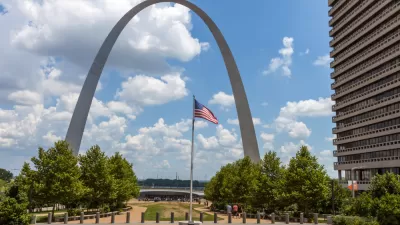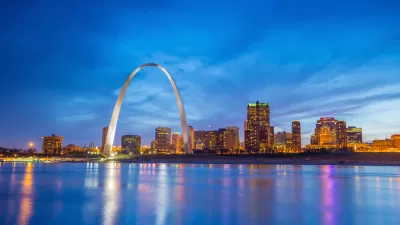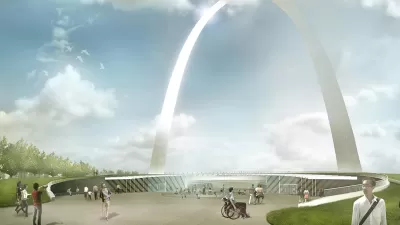Pulitzer Prize-winning critic Blair Kamin assesses the remodeled Gateway Arch in St. Louis, prior to its big public opening on July 3.

The Gateway Arch isn't just a monument to westward expansion—for many it’s a symbol of St. Louis. But in the past, according to a review by Blair Kamin, the monument has "seemed a little removed from the city around it."
For decades, a highway trench and a busy surface street cut off the Arch from nearby downtown. People walking to the Eero Saarinen-designed landmark had to cross narrow highway bridges as cars and trucks sped below. Other visitors would deposit their vehicles in a parking deck on the north side of the Arch’s grounds, take in the 630-foot-tall icon, then leave without ever setting foot downtown.
Kamin's assessment of the newly renovated grounds and museum of the arch will notice how much better the monument now connects to the city (another article by Doyle Murphy posits that the project is also emblematic of a city reconnecting with its river).
The most dramatic new element, a broad land bridge that spans Interstate Highway 44, creates a continuous public park that lets visitors walk uninterrupted from the domed Old Courthouse on one side of the highway to the Arch on the other. Once they cross, they encounter the museum’s new entrance, an elegant and inviting half-circle of metal and glass. New galleries that engagingly tell the story of the nation’s westward drive await below.
In addition to introducing some of the design history of the Gateway Arch, the review also discusses some of the attendance and revitalization benchmarks that will define the success of the project when it's fully reopened.
FULL STORY: Gateway Arch transformed: New landscape, expanded museum better link the icon to St. Louis

Trump Administration Could Effectively End Housing Voucher Program
Federal officials are eyeing major cuts to the Section 8 program that helps millions of low-income households pay rent.

Planetizen Federal Action Tracker
A weekly monitor of how Trump’s orders and actions are impacting planners and planning in America.

Ken Jennings Launches Transit Web Series
The Jeopardy champ wants you to ride public transit.

Sacramento Plans ‘Quick-Build’ Road Safety Projects
The city wants to accelerate small-scale safety improvements that use low-cost equipment to make an impact at dangerous intersections.

How Project Connect Would Change ‘The Drag’
A popular — and sometimes deadly — Austin road will exchange car lanes for light rail.

Milwaukee Road to Get Complete Streets Upgrades
The city will reduce vehicle lanes and build a protected multi-use trail including bioswales and other water retention features on its ‘secret highway.’
Urban Design for Planners 1: Software Tools
This six-course series explores essential urban design concepts using open source software and equips planners with the tools they need to participate fully in the urban design process.
Planning for Universal Design
Learn the tools for implementing Universal Design in planning regulations.
Ada County Highway District
Clanton & Associates, Inc.
Institute for Housing and Urban Development Studies (IHS)
City of Grandview
Harvard GSD Executive Education
Toledo-Lucas County Plan Commissions
Salt Lake City
NYU Wagner Graduate School of Public Service





























